Hello everybody, Please please please take five minutes to contact your elected officials and demand a PERMANENT ceasefire in Gaza. Yes, we are still doing this, because yes, it does have some impact. It must. Collective voice is the power we have. Thank you to everyone engaged in continued action to end the violent occupation of Palestine. I am sending love to you all in this ongoing, enraging, heartbreaking moment.
Maybe you’ve seen the mugs.
Piles of animals, drawn in a thin monochrome line, in red or blue or brown. They’re jumping all over each other, top to bottom, front to back. You wonder: Are they playing? Wrestling? Hugging? Well, yes, they are. But wait. Those rabbits are also… are they? No. Yes. They’re doing it! That bear’s face is in that other bear’s butt! There is a tangled orgy of cats (or penguins, or elephants) on this coffee mug.
I first encountered these mugs while hanging out with Joe Meade, an artist in Nevada City. Joe collects and deals in objects, working with their narrative qualities and potent origin stories. One of his areas of deep knowledge is California-made ceramics. (Some others are Japanese scissors, vintage flashlights, and very old denim.) One afternoon, I joined Joe on a trip to the dump. I opened the passenger door of his baby blue Mercedes wagon to get in and Joe swept a pile of coffee mugs off the seat, rearranging his car full of treasures to make room. “Those are cool, what are they?” I said. “Whoa, dude, you don’t know about Taylor & Ng? You’re gonna love this.” Joe was stoked. “It’s very Bay Area.”

As we inched through the long line at the dump (a great place to contemplate what Joe calls “the acquisition impulse”), he shared a flood of historical and cultural details, as he does. These frolicking animal orgy mugs were evocative of their time and place, Joe said. Illustrated by a prolific gay artist, the mugs were mementos of 1970s and 1980s San Francisco, where gays and artists and gay artists lived and loved and partied and painted, and where AIDS later devastated a creative community and arguably shifted the culture of the entire city forever.1
The mugs were erotic—if you were inclined to see them that way. They were also mainstream: cute little orgy mugs snuck into peoples’ kitchens; the little old lady next door had them in her cupboards. They were mementos of the sexual revolution of the 1970s, brought to the mass-market consumer via fine department stores. They were inherently subversive and many people didn’t even know to look for it.
Taylor & Ng’s Animates mugs were illustrated by the artist Win Ng, a sculptor, ceramicist, and illustrator. Ng was born and raised in San Francisco’s Chinatown, one of eight children. His father cooked and his mother sewed. He studied ceramics at the California School of Fine Arts (which later became the San Francisco Art Institute, RIP) and did part of an MFA at Mills College (RIP). His partner Spaulding Taylor also attended the California School of Fine Arts, where he studied painting.
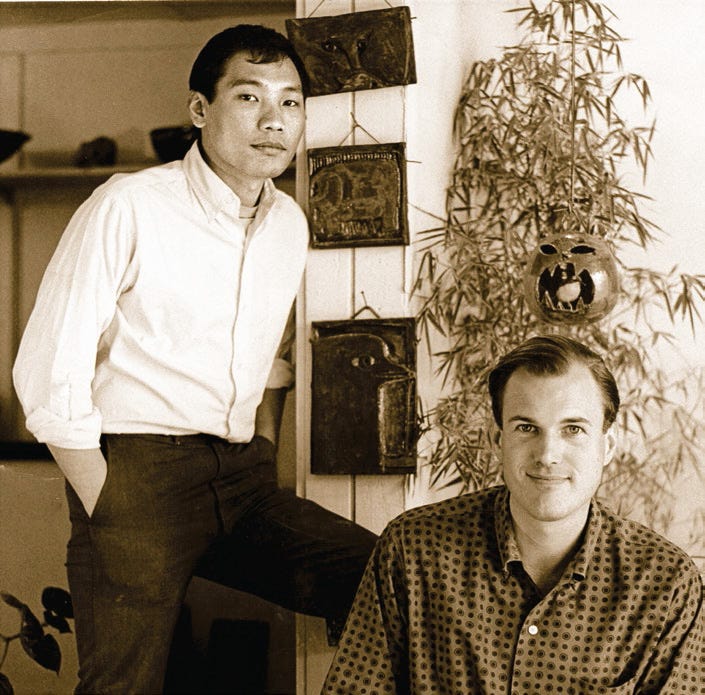
In 1965, Ng and Taylor started a home goods company called Environmental Ceramics company in garage studios in Bernal Heights and later SOMA, years before starting a business in a garage became a Bay Area trope. They later changed their name to Taylor & Ng. The company’s first successful mass-market item was… this chicken-shaped casserole dish.

After the success of the chicken, they went big: Taylor & Ng produced quirky illustrated kitchen linens (which they called “software”!): potholders, towels, napkins, placemats, and aprons. Their “hardware” line included coffee mugs, trivets, plates, bowls, and a quail-shaped casserole dish. They had an eye for highest-quality production and sought manufacturers in Japan to make sure things were *perfect*.




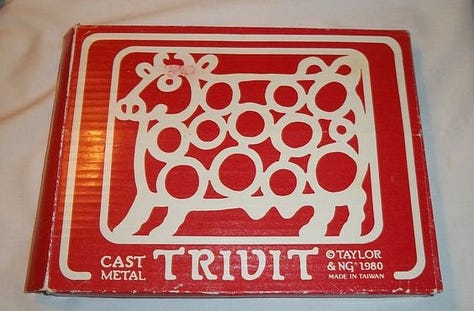

My family cabin has a Taylor & Ng bacon press with a charming little piggy and BACON PRESS engraved in their signature calligraphic lettering.

Good news: this stuff is everywhere, especially if you’re inclined towards thrift stores, flea markets, or shopping on eBay (as I am). I called Joe recently to fact check some of my memories of our hang a decade ago, and he told me that he just made his kid some tea in a Taylor & Ng mug the other day. He doesn’t drink his coffee out of them—no one does, he said. They’re too big for coffee, perfect for tea. “I think they were incredibly savvy,” Joe said, “not just design-wise, but in terms of knowing what people wanted.” He recalled that herbal tea emerged into American supermarkets around the same time as the mugs2.
Taylor & Ng are credited with popularizing the Chinese wok with mainstream western audiences3, which they sold in a very user-friendly kit with colorful packaging, a little cookbook, and stainless steel accessories. T&N have been described as “Williams-Sonoma…with a quirky Chinese Asian flare to it.”4

What started as a side-hustle by two artists (intended to fund their fine art practices) turned into a real-deal business success story: T&N had a giant, multilevel store on the Embarcadero, two stores across from each other on Howard Street, and one in Palo Alto. Macy’s in New York City had its own little Taylor & Ng shop inside the department store. Ads in the Chronicle-Examiner invite the public to T&N-hosted wok demonstrations at Macy’s and Crate and Barrel. Ng’s business-minded brother joined the staff and helped the business grow.

In addition to T&N’s produced home-goods, they imported fine-craft objects from overseas, curating eclectic retail spaces that felt more like the inside of your eccentric, worldly uncle’s home than a store. These shops, bringing fine craft to the mainstream, seem like precursor to so many of the artist-run shop-as-curatorial project shops that we have in the Bay Area today.5 Shopping is a feeling—or it can be—and it seems like T&N created a nice feeling. “He dragged the fine arts mentality into retail,” a friend of Ng’s said, “and was one of the first to treat retail space as though it were a gallery space, and display products like they were art objects.”6

I started this research process feeling absolutely jazzed to immerse myself completely. I love these mugs, but I can’t find very much written about Win Ng! Maybe I could call his family?! Maybe someone would let me into the warehouse! I could go find Spaulding Taylor! And then, I found this article7, packed with facts and photos, which answered so many of my questions. The company sold out of the family in the 1990s. I felt a little deflated and a little relieved. I was off the hook. I could leave some things unknown. I’m not exactly a reporter, I’m more of an obsessive archival sleuth and image-aggregator who likes to write long, emotional captions.
I love Taylor & Ng home goods so much and have come dangerously close to spending hundreds of dollars on eBay to form a near-complete mug collection. However, I most love Win Ng’s book illustrations, which grace a series that T&N published on food-related topics with Yerba Buena Press. (I have spent about one hundred dollars amassing a complete collection.)
I found Herbcraft on my mom’s bookshelf after she died, absolutely charmed by the illustrations and the thick, toothy, cream-colored paper printed with dark brown ink. It took me a while to connect the coffee mugs from Joe’s car to this mystery book, but when I did, I was charged with serendipitous energy, like: these objects are a part of my home, and my life, and my place, and I should learn more about them.

I am of course interested in Ng’s illustrations because they’re beautiful. They’re expressive, playful, and whimsical. They turn the everyday into a sweet, wild fantasy, textured and complex. I want to live in these drawings! I want to browse a cookbook in a kitchen full of cats. I want to sit nude on a toadstool, beside an oversized sprig of mint. I want, more than anything, to live in a teacup terrarium with my fairy lover!
I might love them most because they were not drawn with an iPad. No shade to the iPad illustrations, but lately it’s refreshing to see the analog.
I am also interested in Ng’s drawings because to me they represent the possibilities of a multi-hyphenate creative practice. Win Ng made abstract sculptural ceramic work, shown in fine art galleries, AND he was a commercial artist whose illustrations made their way into kitchens across the world, stowaways on mainstream home goods. Nearly weekly, his drawings ran as advertisements in the San Francisco Chronicle-Examiner.

Only so many artists can make a living showing their work in commercial galleries. I don’t think anyone is less of an artist for making products to sell or lending their work to mass-produced objects, but that opinion exists. I think it’s still a fraught divide for many artists, feeling pressure from the amorphous Art World (capital A and capital W) to show only rarified artworks in commercial galleries, and not dilute the work by making it “overly” available. Scarcity drives sales of high-priced work, I get it.
Ng was not exempt from this narrative; an artist profile notes “Many traditional critics feel that Ng’s important work dates from 1958 to 1965, the years before he shifted his creative output from gallery art to more functional work.”8 Of course, this is critic-speak, which can’t always be trusted, but his younger brother Herman said, “Win never talked about it, but fine art was where his real soul was.”

Lucky for us, Ng’s practice encompassed both fine art and functional art. “He was doing what he felt he needed to do,” Ng’s sister Mimi says of his work for Taylor & Ng, adding that he enjoyed “the whimsicalness of it. The enthusiasm he received, the positive feedback for his creations, the bunnies and the bears.”
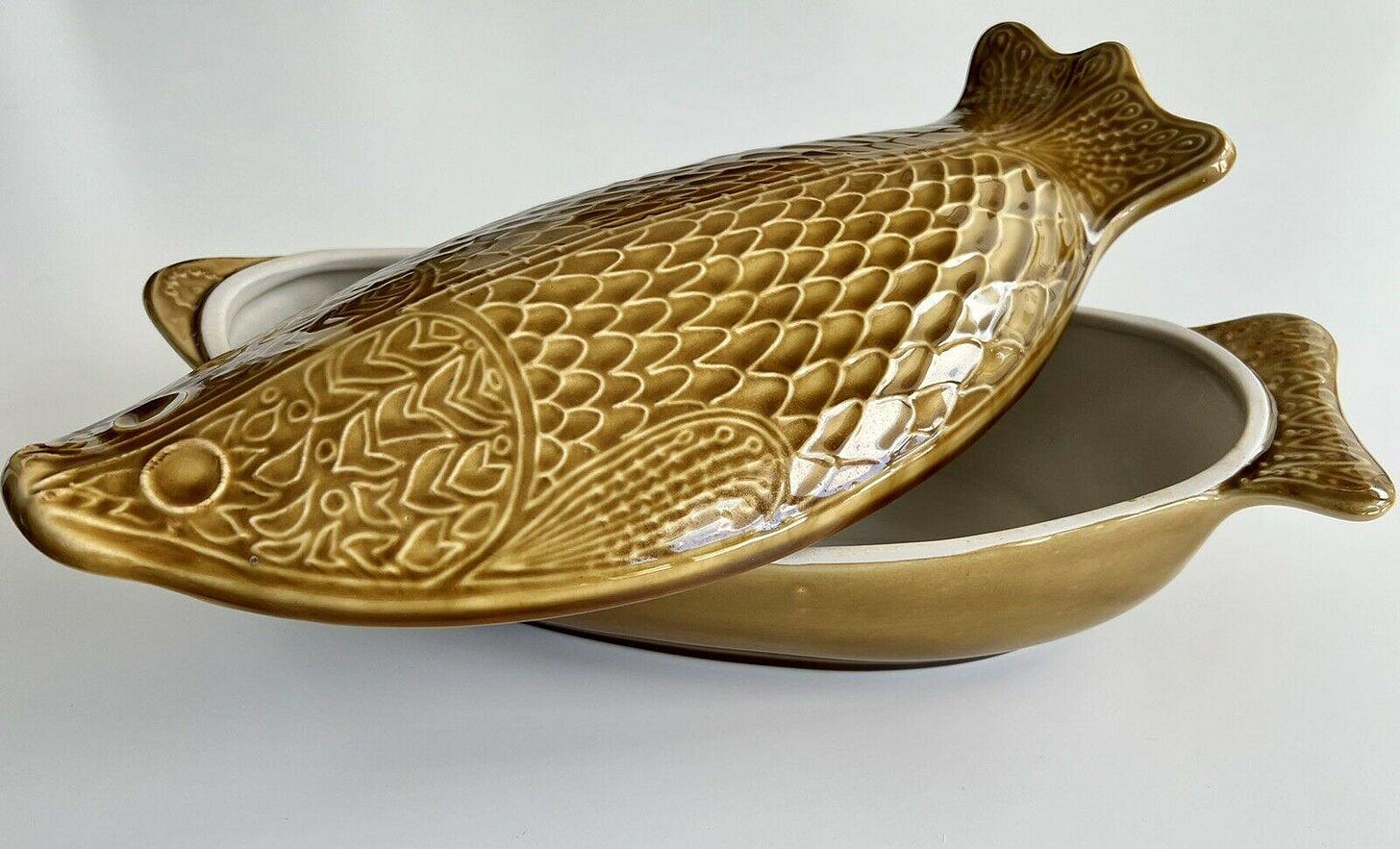
I am a big advocate for art for people: regular people, people who don’t go to art galleries, and people who cannot afford to collect one-off fine art pieces. I think fine art objects often speak an Art-World vernacular that’s unintelligible unless you are “into art.” Ng made fine art destined for the gallery, but he managed also to make art for the rest of us.
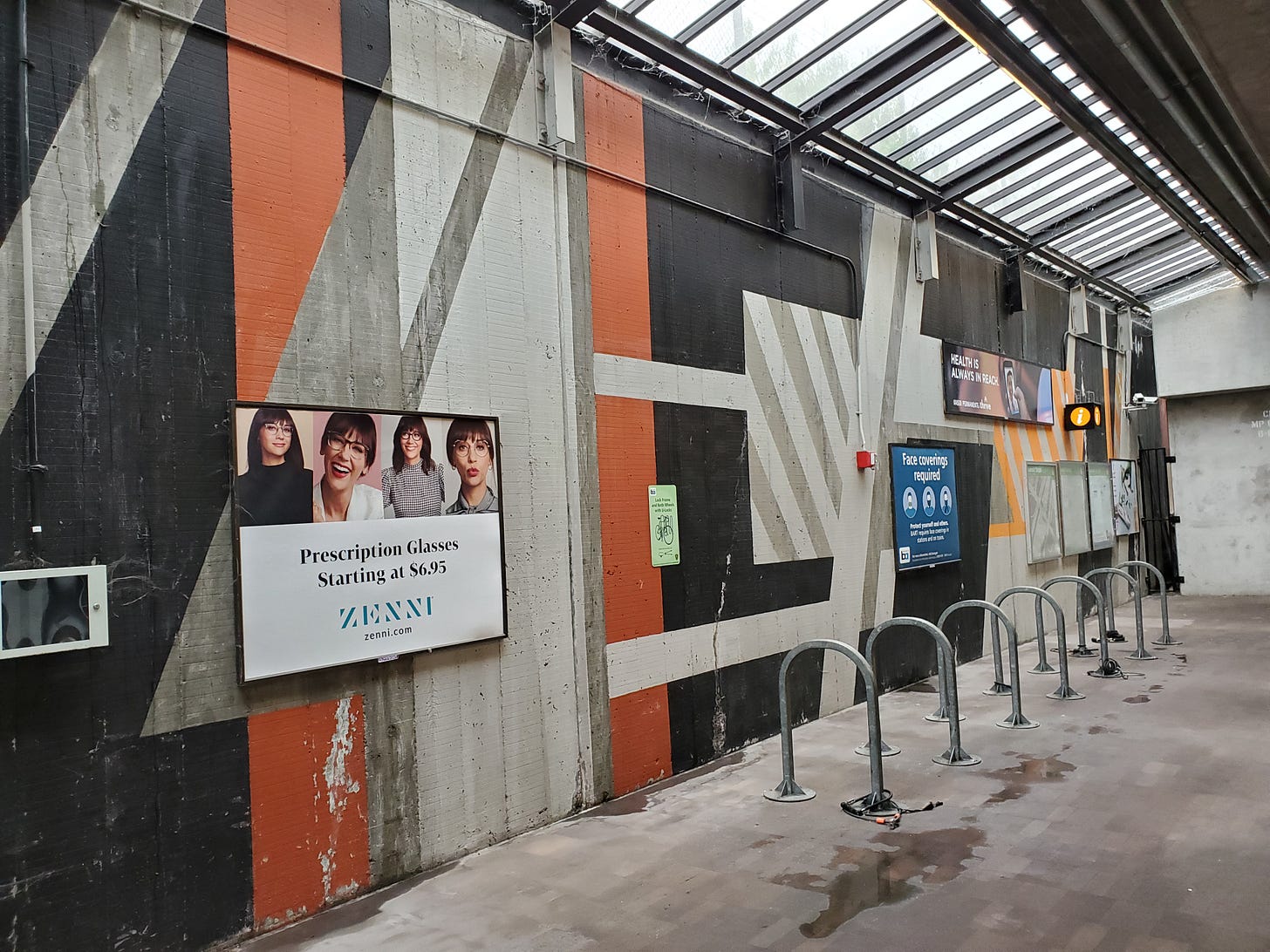
During the height of his homegoods-business era, Ng also created two large-scale works of public art in the Bay Area. In the 1970’s he made a mural at the Orinda Bart Station, which is a little worse for wear these days. The other is a 1968 ceramic tile collage that graces the entrance of a public health building in the Western Addition, which was preserved and amplified in a recent renovation. Hooray for art for regular people! Hooray for art for public spaces.

Ultimately I think I’m so attracted to the work of Win Ng and Taylor & Ng because it all feels like a quintessential Bay Area story, built up from exactly this place. Just like Joe Meade told me a decade ago: “You’re gonna love this, it’s so Bay Area.” What is the word I’m looking for? The story of Taylor & Ng isn’t a parable. It’s not exactly archetypal. It’s a story rooted in place, evocative of the cultural nuances and everyday histories of this slice of earth. It’s a topo-narrative. (Did I just coin that term? Is it working?)

The geography of the Bay Area is cooked into the story of this home-goods company and the artist whose vision brought the flair: his origins in the biggest Chinatown on the West Coast, a chapter spent inside ye olde SFAI perched on the hill, unfolding plotlines from a house on Bernal Hill, a basement on Folsom Street, and a massive warehouse studio-residence three blocks from the heart of the Castro, international center of gay culture. Half an MFA at Mills College, perched in the Oakland Hills. Wok demos at Tanforan Mall. Sales at Macy’s at Union Square. Storied parties at Ruth Asawa’s house in Noe Valley.

It’s hard not to feel nostalgic, especially about a place whose cultural history has been SO documented and mythologized. (“Historical nostalgia” or anemoia is nostalgia for a time or place you never experienced. It sounds like an affliction, and I certainly suffer from it!) Once upon a time, Bay Area artists—including Ng— found a home and a community for their creative practices and pursuits, something that feels difficult these days in the midst of an affordability crisis and the subsequent scattering of artists from the centers of the Bay.9

Digging through histories of Bay Area artist culture brings up a special mix of feelings: comfort, yearning, connection, gratitude, frustration, rage, helplessness. It’s exciting to learn lineages and feel connected to artists through place, AND it’s heartbreaking to see what types of lifestyles and communities thrived then, but often feel impossible to experience now.

Things change. Everything does. Shops close, condos are build, businesses are sold, historic places get renovated, people die. To remedy these tender feelings of historic sentimentality, I try to turn my head towards what’s happening now (BE HERE NOW, YA KNOW) and seek out the “only in the Bay Area” artists, practices, creative places, and communities that are thriving here despite the odds.10 Yes, there are still artists in the Bay Area! Surviving, and in some cases, thriving.
Ng died in 1991 at the age of 55, from AIDS-related causes. In the final decade of his life, he left the homegoods business and returned to making fine art. In 2005, Ng’s brother-in-law Allen R. Hicks curated a retrospective at the Chinese Historical Society of America on Clay Street in Chinatown.

I think Ng is seriously under-appreciated in the canon of Bay Area art history. Hicks, his brother-in-law curator, wrote of Ng’s abstract ceramic sculptural work: “Ng may not have been given credit for being ‘ahead of his time’ for other reasons, the least of which could have included his marginalization as Chinese and his turn to the craft-orient work of Taylor & Ng just as his fine art career was blossoming.”

When I began this research, I was hoping for at least a full-blown online artist profile, maybe on SF MOMA or the Asian Art Museum’s website. Maybe a browsable archive website, grant-funded and maintained by his estate or an independent researcher. No dice. I can’t find the catalog from his retrospective anywhere online.

Joe Meade’s expertise on California-made ceramics runs DEEP, and he helped me contextualize Ng’s work in a larger art-historical landscape. He shared a lot of detailed information, but my basic takeaway was this: as early as the 1950s and into the 1960s, there was a move within ceramics away from craft and towards experimentation and expression. Artists like Peter Voulkos and his student Stephen de Staebler were making wild ceramic sculptures on a monumental scale. Big stuff. Lots of clay. The Funk art movement was percolating at UC Davis, with Robert Arneson driving the inclusion of ceramics as a form of fine art. Over in the Carquinez Hills, Funk artist Clayton Bailey took ceramics to a whole new level of weird. Ceramics “had always been craft,” Joe told me, “until this moment and these makers.”

I’m not an art historian, and I don’t know what was happening with ceramics globally at this moment, but it’s undeniable that there was something special going on in California at this time. And Ng was HERE. He was making, showing, learning, and socializing alongside these people. While Ng received profiles in the business and culture sections of newspapers during his lifetime, his legacy in the California art-historical record is seriously lacking.

The best “institutional” profile I found for Ng was from Rehistoricizing.org, a project that offers a small antidote to my critique. Rehistoricizing is a public history project reframing the narrative around Abstract Expressionism (1950s and 1960s) in the Bay Area. This was the time of Jackson Pollack, Mark Rothko—dudes who have become household names, who Rehistoricizing describes as “white men whose appeal was based as much on talent as a cult of personality.”
Rehistoricizing presents the work of women artists and artists of color from varied ethnic and cultural backgrounds… [working in] an era in which the artist hero was almost always a white male. How did artists who did not fit the white male mold survive in this milieu and make the work they were compelled to make? How can we learn from their experiences?”
These are great questions. I ask myself these questions all the time. How do artists survive, especially in the Bay Area? How can I be an artist completely outside of the “artist hero” narrative? How can I learn from the experiences of others? How can I learn from my own?

Hicks wrote that at the end of his life, Ng worked to bring all the parts of himself together into an integrated whole, his greatest work being his artistic life.
As I make less art these days (mostly I make tiny lunches for daycare, and click around the computer screen for paychecks), I am bolstered by the idea that an artistic life can be the work. Fine art, commercial art, mugs, sculptures, murals, whatever: maybe our creative, intentional, unconventional and artistic lives can be our greatest works. Maybe the intangible stuff—the community energy we nurture, the relationships we build and maintain, the ways we spend our time, and the choices we make in pursuit of connection and creativity—maybe that’s the ultimate work.
Thank you, Win Ng.
Thanks for coming along on my writing and research journey. I love your comments; tell me what you’re thinking! I will try to reply to all of them! Stay tuned for the next one. I’m having fun.
Big thanks to everyone who has opened, read, commented, shared, re-posted, recommended, and linked! I appreciate you so much. Every little click you make encourages me to keep it up.
P.S. I’m not a journalist! I do my research on the internet. Please fact-check me, I’m ready for it!
If you’re interested in the cultural shift brought on by the AIDS epidemic, I *highly* recommend this book by Sarah Schulman: Gentrification of the Mind: Witness to a Lost Imagination
Ok, I can’t find a ton of information on the rise of herbal tea in the US mainstream, but Celestial Seasonings *was* founded in Colorado 1969, which makes sense in so many ways. Maybe my next rabbit-hole?
Winning Ways, author Dave Weinstein for the Eichler Network blog
Some Bay Area stores that display objects like art: Gravel and Gold, General Store, Visions, Tail of the Yak (RIP!)
Bay Area artists are decentralized, and, unless we happen to work in tech or benefit from generational wealth, we’re also struggling financially and experiencing housing insecurity… but that is a set of topics for another post.
BE HERE NOW is a good assignment for me as I plot the editorial direction of this here Substack. I think it’ll likely flip flop between the two: historic/nostalgia and present-day creative energy, rooted in place. A little bit of THEN, a little bit of NOW, and a whole lot of HERE.


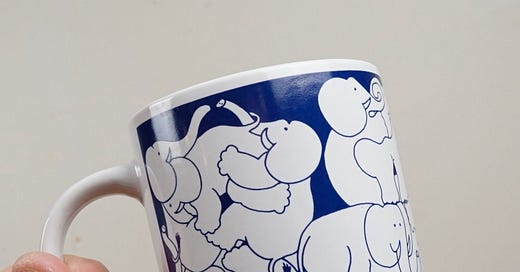












Nicole!! I have long been obsessed with Taylor & Ng, and so appreciate all of this added context. I have a small mug collection (I'm committed to finding them in person for whatever reason, and have a preference for the off-white ceramic) and once had like.... five copies of Wok Craft, just buying them whenever I see them. I loved giving them away and showing folks my favorite illustrations. The orgy mugs are great, and I love the French ones, too. Thank you for this deep dive! Should I get a Win tattoo? xoxo -- Sofie, partner of Andrew B.
delighted to be introduced to these artists’ work. finding your observations on the importance and rarity of embracing a multi-hyphenate (craft/fine/public/retail/etc.) art practice here mega relatable. loved reading the article, thank you!